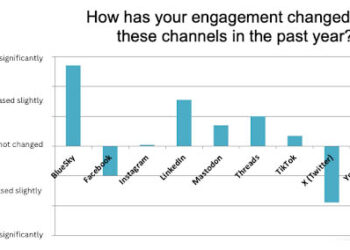
An article published in November details the increasing success of a UK/Canadian/Indian startup called Datawind, which has produced a tablet computer with a 7″ screen that will be sold to university students and professors in India at a retail price of $20. The initial shipment will be 100,000 units, but according to the article, “if things go well the government plans to order as many as 5.86 million.” American reviewers who have tried out the device have been enthusiastic.
Does this development represent an international ecosystem destabilizer, a flash in the pan, or something in between? It’s impossible to know for certain yet, but some interesting questions do suggest themselves at this point.
India is an English-speaking country with a population of 1.2 billion, only 5% of whom currently own a computing device. If the introduction of super-cheap tablet computing brings that percentage to 50%, it will come close to doubling the number of English-speaking Internet users in the world. If this happens, it could happen very suddenly. Given that English is the international lingua franca of science scholarship, what kinds of stress might this put on our existing scholarly communication ecology?
India’s cellular networks are overtaxed now, and the vast majority of Indians have only basic cellphones without computing capabilities. How would India’s infrastructure respond to a sudden and dramatic increase in networked data demand?
Although the $20 retail price of the Aakash 2 is artificially low due to government subsidy, its real wholesale price is only $45. Future versions will be cheaper. This means that virtually universal tablet ownership is now a real possibility, and it’s worth asking ourselves what impacts this might have on college campuses worldwide.
For example, a company called Boundless.com currently produces free online textbooks that are designed to compete directly with standard textbooks in “commodity courses” such as Intro to Economics and Biology 101. Drawing on freely and legally available online documents, the “Boundless Alternative” version of a standard text compiles the same basic information into chapters that follow the same outline as the target textbook. The important question for the academic market is not whether such a “textbook” is just as good as the $200 real thing, but whether it is good enough to make large numbers of students comfortable with foregoing purchase of the real thing. How might virtually universal tablet ownership affect students’ decisionmaking in this regard?
This is a development well worth watching — for publishers, campus bookstores, IT managers, and libraries.
Discussion
21 Thoughts on "The $20 Tablet, and Four Interesting Questions for the Academic Market"
“will be sold to university students and professors in India”
WRONG… the tablets are planned to be supplied to schools (in India Schools do not mean colleges, if that’s where you got confused) and secondly, they will not be SOLD by Government rather given to schools.
You’re correct that the tablet will be sold to the government for distribution to students; I misstated that, and appreciate the correction. However, the article I cited states clearly that the tablet will be distributed to “100,000 university students and professors.” I wondered if the article was mistaken, so I investigated further and found a recent BBC report that says the same thing, and that includes a photo of students who are quite clearly of college age, posing with their Aakash tablets.
This sounds wonderful! I suspect that building the Internet infrastructure will be the long pole in the tent, which might take several decades to do, and not just in India. But as you suggest the big question for us is what will be on the screen? In that context I have developed some lesson plans that have no content, relying entirely on search results. But the big issue with students having computers in the classroom is how do you control their attention? Problem solving may replace teaching.
In the college classroom, my impression (and recollection) is that textbooks are used fairly infrequently. You read the textbook outside of class and discuss the concepts in class. If these cheap tablets are used that way, then they shouldn’t be terribly disruptive to standard models of classroom instruction–but they may well pose a big threat to traditional textbook publishing.
I’d value an expansion from you at some time on the idea of how problem solving may replace teaching.
I should probably do a Kitchen article on this but the issue is how to use the student computer in the classroom? It is already common to use a single computer projected and controlled by the teacher, looking at the Web. So-called inquiry methods already have students doing discovery but these tend to be very inefficient compared to instruction when it comes to conveying core concepts in science.
My idea is that instead of being taught about something like ground water (I used to be a groundwater engineer) the students would be challenged to go learn about it on the Web. If this were done frequently the students should become discovery experts. One interesting aspect is that different people learn in different ways so students could use those sources that work best for them, once they found them of course. Learning becomes a problem to be solved.
Regarding what works best my research indicates that every book and teacher is confusing in certain ways that differ from case to case, which I call the output coherence profile of that source. (I have a diagnostic system of 126 kinds of confusion which I call coherence analysis.) Each student is likewise most easily confused in certain ways, their input coherence profile. When a student meets a book or teacher that is confusing in the specific ways that they find most confusing communication tends to break down. So being able to find one’s own best sources might reduce this problem.
Unless you haven’t been paying attention, you know that the textbook is about to be disrupted in a big way. It is going to happen with or without cheap tablets, though cheap tablets and an international market won’t hurt.
Boundless has a very interesting model, they collect free/open web content and fashion it into a textbook replacement that mirrors established textbooks. They have attracted both venture capital and are being sued by the major textbook publishers. See the article in this morning’s Slate on the textbook alternatives. There is another article from the MIT Review. Most interesting to me is a recent “hackathon” sponsored by Boundless that gathered a group of physicists to put together an intro textbook. They got a third of it finished in a weekend. And then there is the California initiative to produce open textbooks for the top enrolling 50 courses. These are the courses where textbook publishers make the big bucks.
Traditional textbook publishers will have an increasingly difficult time holding on to their income streams as students and increasingly faculty look to alternatives that are becoming easily and freely available. There may be a few more reasonable years for traditional textbook publishers, but change is inevitable and their business model will not hold.
You might want to note that Boundless has been sued for copyright infringement by several leading textbook publishers.
Rick, the other commenters are missing your point. The impact of adding another billion or so people to the internet, with a particular locus in education, is massive. And with tablets under $50 (and falling), that will happen. Whether it is this tablet in particular is irrelevant as is the detail of who specifically the Indian government is subsidizing in the immediate future or what software company is doing what to whom with some textbooks scheme at the moment. Getting bogged down in the specifics of this deal misses the large point: “good enough” tablet computers are available at a price point that can be afforded (with or without various subsides by various governments) by hundreds of millions of people that cannot currently afford them AND they are ideally positioned as a learning tool for hundreds of millions of students. This is what is known as a tipping point for tablet computing and for educational content distribution.
Michael, you’re right that that’s my main point and the one that I think is both most troubling and most exciting. But I don’t mind engaging ancillary issues as well. 🙂
I am not sure these folks have $50 billion in spare cash for tablet computers, since many do not even have electricity. Nor is their education system about to revolutionize in ways ours has not with all our money. As I said I think this is wonderful but let us see some serious analysis.
It’s true that we haven’t experienced a revolution in our education system up to this point. It’s also true that we haven’t had access to $20 tablet computers. You can’t do serious analysis of a development like this until it’s too late to prepare for it, which is why I suggest asking ourselves questions like the ones above now, while the impact is still hypothetical.
Of course we can do analysis just not planning. We are probably talking about a 20 year transition.
There are a lot of different issues here but I do not necessarily see an education revolution in the making, just a lot more people getting Internet access, which is wonderful. On the other hand free or 99 cent textbooks would be nice, or even the no textbook case I describe above. The Web is full of free edu content from K to college but it is very scattered. Something like Google Scholar for k-16 edu would be great, which is why I developed a search algorithm that estimates the grade level of science edu content.
But textbooks are very efficient, as is teaching. Many of the utopian visions for education fail to recognize these two facts. My team mapped the knowledge flow of k-12 science education and it is impressive. Education is a finely tuned cognitive production system. Cheap tablets may not change that. But first we need to sort out the many different issues.
Potential change doesn’t have to be revolutionary to be worth thinking about ahead of time. My piece suggests that we pay attention to these developments and think about their possible implications, not that we run around in circles waving our hands over our heads and screaming.
I take it then that you agree with me that analyzing these issues is worth doing. As to the question of Indian infrastructure these folks are world class IT engineers so I am pretty sure they have analyzed the issue. But are we talking about the 100k units, or the 6 million, or Michael’s one billion? There is a difference.
As a student of techno revolutions the first question is always what time frame are we talking about? People jump from years to decades with little thought.
I take it then that you agree with me that analyzing these issues is worth doing. As to the question of Indian infrastructure these folks are world class IT engineers so I am pretty sure they have analyzed the issue.
Maybe they have, but if so, it hasn’t done much good yet. Right now it seems clear that they’re nowhere near ready to deal with a sudden and significant increase in networked data demand. They can’t even handle the demand they have now, and only 5% of their population is currently using devices that move data to and from the network. Apparently not even their cellphone networks work consistently or robustly; while interviewing the CEO of Datawind for the article I cited, the author kept being interrupted because the CEO couldn’t keep a steady connection to the cell network in Mumbai. A colleague of mine who lived for several months in India tells me that “the networking infrastructure over there is ridiculous (when we had internet ‘installed’ in our apartment, they literally strung a cable, suspended by telephone poles, from the relay box to our porch and routed it through a slightly-open window).” His opinion, based on his experience there, is that any significant new strain on the data networks would cause them to “crash and burn.” So despite the presence of world-class IT engineers, India already has a serious infrastructure problem, and it now appears likely that there will be a sudden increase in demand for networked data exchange.
But are we talking about the 100k units, or the 6 million, or Michael’s one billion?
As I said, we’re definitely talking about 100,000 now; there are tentative plans for another 5.86 million. Michael’s point, I believe, is that if tablet computing prices continue their current trend, it’s only a matter of time before the great majority of India’s citizens have access to the internet, and the knock-on effects may well be tremendous. My point is that it’s a good idea to think about what those effects might be, and that it might be wise to think about them now, rather than waiting until after they’ve happened.
Now we are getting somewhere. The first question is can the existing physical system support 100k tablets without crashing. My guess is it can as it is a big country but response times may be poor or even intermittent As you note that is already the standard. Universities are concentrated so may be easier to upgrade a bit. If the time frame for the six million is five to ten years it may be doable. The billion is more likely global, not India, and twenty years out. Then there is the separate issue of these little hummers swarming in the rich countries. They are practically disposable.
Your other questions are more interesting but less well defined.
Reblogged this on Construction Management and Economics and commented:
Cheap computing for the developing world. Will it happen?



